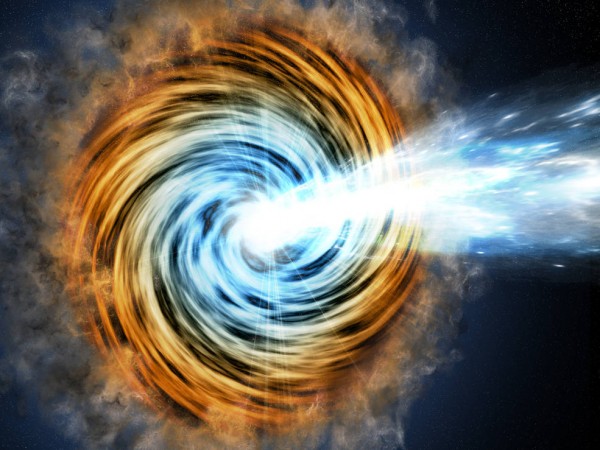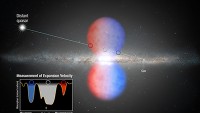Most Powerful Gamma Rays Travelled Halfway Across the Universe to Reach Earth
| Ana Verayo | | Dec 16, 2015 08:18 AM EST |
(Photo : M. Weiss/CfA/NASA) Black-hole-powered galaxies called blazars are the most common sources detected by NASA's Fermi Gamma-ray Space Telescope.
An extremely rare outburst of gamma rays that have been travelling across the universe has been detected by NASA's Fermi Gamma-ray Space Telescope where this new discovery sheds new information about the highest light energy ever observed from a distant galaxy.
Like Us on Facebook
These rare gamma rays originate from an active galaxy known as PKS 1441+25 which is also called a "blazar", located so far from the solar system, that apparently took 7.6 billion light years to reach Earth.
A blazar is among the extremely brightest cosmic objects in the known universe which is powered by a supermassive black hole, enshrouding itself within hot gas and a disk of dust. This black hole is also estimated to possess 70 million times the mass of our sun.
The telescope then revealed that these gamma rays measure up to 33 billion electron volts which is the highest energy recorded in the telescope's detection range. These rays are so powerful that visible light energies only measure between two to three electron volts only. Apart from this Fermi discovery, the team from the Major Atmospheric Gamma-ray Imaging Cherenkov (MAGIC) experiment also measured this particular blazar and found that they possess gamma rays of energies ranging from 40 to 259 GeV.
NASA officials revealed that since this galaxy is so distant, there was little to be expected of gamma ray detection with extremely high energies. Ultra high gamma rays like these then transform into particles when they collide into light with low energies.
These gamma rays are so ancient that they travelled halfway across the universe, making their estimate age at half of the universe's which is 14 billion years old. Earth has only been existing for 4.5 billion years.
This depicts a colossal amount of distance for this journey in order to be detected by ground based telescopes on Earth. However, apart from this, the rays also had to pass through this space net of photons called extragalactic background light. When these gamma rays pass through this starlight, they split into two particles made up of an electron and a postiron.
Scientists from University of California, Santa Cruz were certainly surprised with this discovery where the VERITAS (Very Energetic Radiation Imaging Telescope Array System) telescope also detected these rays at 200 GeV from PKS 1441+25.
This energy flare revealed new insight about extragalactic background light's various range of wavelengths, from near infrared to near ultraviolet where this distant galaxy's energy also link to extragalactic background light's sources. This can help scientists in tracking the universe's history since extragalactic background light comes from all the galaxies that ever existed in the universe.
This new study is published in The Astrophysical Journal Letters.
TagsGamma rays, ancient powerful gamma rays, powerful gamma rays reach earth, NASA FERMI telescope, PKS 1441+25, blazar
©2015 Chinatopix All rights reserved. Do not reproduce without permission
EDITOR'S PICKS
-

Did the Trump administration just announce plans for a trade war with ‘hostile’ China and Russia?
-

US Senate passes Taiwan travel bill slammed by China
-

As Yan Sihong’s family grieves, here are other Chinese students who went missing abroad. Some have never been found
-

Beijing blasts Western critics who ‘smear China’ with the term sharp power
-

China Envoy Seeks to Defuse Tensions With U.S. as a Trade War Brews
-

Singapore's Deputy PM Provides Bitcoin Vote of Confidence Amid China's Blanket Bans
-

China warns investors over risks in overseas virtual currency trading
-

Chinese government most trustworthy: survey
-

Kashima Antlers On Course For Back-To-Back Titles
MOST POPULAR
LATEST NEWS
Zhou Yongkang: China's Former Security Chief Sentenced to Life in Prison

China's former Chief of the Ministry of Public Security, Zhou Yongkang, has been given a life sentence after he was found guilty of abusing his office, bribery and deliberately ... Full Article
TRENDING STORY

China Pork Prices Expected to Stabilize As The Supplies Recover

Elephone P9000 Smartphone is now on Sale on Amazon India

There's a Big Chance Cliffhangers Won't Still Be Resolved When Grey's Anatomy Season 13 Returns

Supreme Court Ruled on Samsung vs Apple Dispute for Patent Infringement

Microsoft Surface Pro 5 Rumors and Release Date: What is the Latest?













